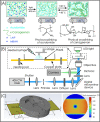Printing Double-Network Tough Hydrogels Using Temperature-Controlled Projection Stereolithography (TOPS)
- PMID: 37319377
- PMCID: PMC10316326
- DOI: 10.1021/acsami.3c04661
Printing Double-Network Tough Hydrogels Using Temperature-Controlled Projection Stereolithography (TOPS)
Abstract
We report a new method to shape double-network (DN) hydrogels into customized 3D structures that exhibit superior mechanical properties in both tension and compression. A one-pot prepolymer formulation containing photo-cross-linkable acrylamide and thermoreversible sol-gel κ-carrageenan with a suitable cross-linker and photoinitiators/absorbers is optimized. A new TOPS system is utilized to photopolymerize the primary acrylamide network into a 3D structure above the sol-gel transition of κ-carrageenan (80 °C), while cooling down generates the secondary physical κ-carrageenan network to realize tough DN hydrogel structures. 3D structures, printed with high lateral (37 μm) and vertical (180 μm) resolutions and superior 3D design freedoms (internal voids), exhibit ultimate stress and strain of 200 kPa and 2400%, respectively, under tension and simultaneously exhibit a high compression stress of 15 MPa with a strain of 95%, both with high recovery rates. The roles of swelling, necking, self-healing, cyclic loading, dehydration, and rehydration on the mechanical properties of printed structures are also investigated. To demonstrate the potential of this technology to make mechanically reconfigurable flexible devices, we print an axicon lens and show that a Bessel beam can be dynamically tuned via user-defined tensile stretching of the device. This technique can be broadly applied to other hydrogels to make novel smart multifunctional devices for a range of applications.
Keywords: additive manufacturing; digital micromirror; double-network hydrogel; mechanically reconfigurable soft devices; projection stereolithography.
Conflict of interest statement
The authors declare no competing financial interest.
Figures







References
-
- Wang Y.; Zhu C.; Pfattner R.; Yan H.; Jin L.; Chen S.; Molina-lopez F.; Lissel F.; Liu J.; Rabiah N. I.; Chen Z.; Chung J. W.; Linder C.; Toney M. F.; Murmann B.; Bao Z. A Highly Stretchable, Transparent, and Conductive Polymer. Sci. Adv. 2017, 3, e160207610.1126/sciadv.1602076. - DOI - PMC - PubMed
-
- Calvert B. P. Hydrogels for Soft Machines. Adv. Mater. 2009, 21, 743–756. 10.1002/adma.200800534. - DOI
Grants and funding
LinkOut - more resources
Full Text Sources

